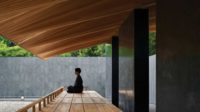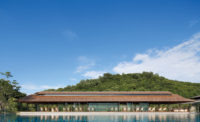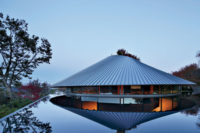Hiroshi Nakamura & NAP Complete White Lily–Inspired Our Lady of Lourdes Chapel in Manila

Architects & Firms
Topped by a dramatic, 98-foot-high spire, the Our Lady of Lourdes Chapel is both an eye-catching structure and a dignified place of worship. Designed by Tokyo-based architect, Hiroshi Nakamura, it sits atop a hill in Filinvest City, a newly-built planned community 16-miles south of central Manila. The result of an invited competition hosted by the client, Filinvest Alabang, the project is Nakamura’s first completed work in the Philippines. The architect has realized several sacred spaces in Japan, including the Sayama Forest Chapel and the Ueno Toshogu Shrine Meditation Pavilion. Despite their different environments and religions, each of these buildings embraces the soul and embodies spirituality.
Our Lady of Lourdes Chapel, Philippines. Video © Filinvest City, videography by Earl Lasangue
This project consists of two independent, six-sided buildings: the 750-square-foot prayer room containing an ossuary and the 10,765-square-foot chapel. Located on the north side, the chapel’s main entrance leads directly into the 300-seat sanctuary occupying the ground floor. The basement level holds the sacristy, staff area, and cry room, where families can attend services with small children without disturbing the congregation, along with other support spaces. Though the site’s proximity to a shopping mall might seem like an unlikely spot for a place of worship, the topography and the nearby Alabang River separate Nakamura’s project from its commercial surroundings. To accommodate vehicular access plus a small parking area, Nakamura modified the hill’s gradation slightly. But most visitors approach on foot, following a meandering path where they can reflect and prepare for prayer while moving from the secular to the sacred.
The shape of each building was inspired by the white lily flower, a symbol of purity associated with the Virgin Mary. In both cases, six petal-shaped planes are seamlessly blended to create the continuous surface that serves as the walls and roof. In contrast to conventional, masonry churches that are firmly planted on the ground, Nakamura’s chapel respects the shape of the hill without overwhelming the landscape. Instead, it perches gracefully at just six points where the inverted petals touch the earth. “We wanted the tips of the lily to be as delicate as possible,” explains project architect Kohei Omori. Outside, this was achieved with aluminum panels supported by steel trusses. The size and thickness of the metal panels required careful study due to the building’s undulating overall form. Where the petals dip and the curves tighten, the panels had to be smaller and thinner. In the case of the chapel, the six petals are interspersed with slit-like, stained-glass windows created by the British designer Helen Whittaker. Represented with a rainbow of colored glass, their motifs are abstract lily blossoms.
Inside the chapel, the petals become a billowy ceiling crafted from narrow aluminum strips. “Upon entry, you can touch the ceiling since it touches the ground,” observes Omori. Lining the space, teak pews designed by Nakamura echo the building’s gentle shape with their curved ends. The seating is oriented towards the altar where a metal sculpture created by the Filipino artist, Daniel Dela Cruz, depicts the resurrection of Jesus Christ. While the colored glass is reflected on the metal surface, soft daylight filters down through the 7-foot-diameter, fixed skylight topping the spire. Ringing the base of the skylight, small openings create a chimney effect by drawing cool air from the river up through the sanctuary—on weekdays, passive cooling is sufficient. But on Sundays, when the pews are full, a mechanical air conditioning system chills the space. The daylight from above is augmented by rays of light streaming in from the sides through the stained-glass windows as well as spotlights attached alongside their sash.
In addition to the tropical climate, the architects also had to accommodate the local construction culture which varies considerably from that of Japan. “There were a lot of challenges that we had never faced before,” recalls Omori. Chief among them was construction management. Unlike in Japan, the subcontractors worked independently, requiring the architects to take on a supervisory role to ensure the quality standards down to the exacting details. But the power of Nakamura’s architecture overcomes international divisions. The play of light, shadow, and surface yields a place of worship with universal appeal. “We wanted to provide a space for prayer where all people can pause and reflect,” says Nakamura.
Chapel section. Click to enlarge

Upper level plan. Click to enlarge

Lower level plan. Click to enlarge

Site plan. Click to enlarge

Images courtesy Hiroshi Nakamura & NAP




